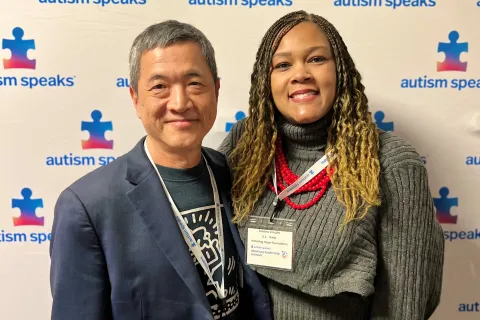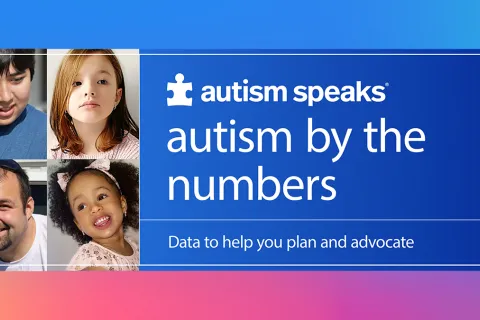Can brain scans help personalize autism therapies and supports?
This Autism Speaks research fellow has developed a test that helps predict who will respond best to certain behavioral therapies and coaching programs
By social neuroscientist Yung-Jui (Daniel) YangYung-Jui (Daniel) Yang is a social neuroscientist of the Autism and Neurodevelopmental Disorders Institute at George Washington University. An Autism Speaks Meixner Postdoctoral Fellowship in Translational Research supported the research Dr. Yang describes here.
Autism brain scans
I’m glad to tell you about the promising findings of the research supported by my Autism Speaks Meixner Fellowship. My team is developing and testing methods that predict how well someone with autism will respond to certain behavioral therapies and social coaching programs.
The goal is to provide guidance to families and individuals affected by autism so they can make informed choices for treatment and support. It’s also in line with the growing appreciation that each person with autism is unique and does best with a personalized intervention program.
Knowing who will benefit most from an intervention – and at what point in their lives – will also allow us to adjust treatment approaches to maximize benefit, avoid excessive costs and – in some cases – flag when a different or more-intensive program is more likely to produce the desired benefits.
Tracking response to biological motion
In this line of research, we use magnetic resonance imaging (MRI) to track brain activity while study participants perform a task that involves recognition of biological motion. Take a look at the figure below. The image on the left side of the figure shows points of light that follow the movements of a person performing a social action such as waving hello or playing pat-a-cake.
As you can see, we kept the number of lights to a minimum. They display only the movements of major joints.
An abundance of past research has shown that most people readily grasp that this type of point-light display represents a moving human being. This research has likewise shown that, for most people, this type of “biological motion” provokes a strong response in brain regions associated with learning and processing social information. We can view these brain responses noninvasively as they occur by having a study participant lie in an MRI machine while looking at the point-of-light displays.
In our studies, we paired this biological-motion point-of-light display with another that showed scrambled motions. (The image on the right of the figure above.) The moving lights in this second display have no social meaning. Typically they don’t activate the social centers of the brain.
With the help of study volunteers affected by autism, we explored whether someone’s brain response to biological versus scrambled motion could predict whether he or she would benefit from a given behavioral therapy or social training program.
We did this with two very different groups of people affected by autism: young children and young adults. And each group completed a very different intervention after completing the biological-motion task.
In the first study, 20 young children (average age 6) received 16 weeks of Pivotal Response Treatment. It’s a play-based intervention based on Applied Behavioral Analysis.
In the second study, 17 adults on the spectrum completed a 5-week program called Virtual Reality-Social Cognition Training. This program enables participants to practice important social skills under the guidance of a therapist using a virtual-reality “game” that simulates situations such as a job interview, a blind date, etc. Both the participant and the therapist interact via digital avatars.
Brain responses predict readiness for social training
In both studies, we saw an overall improvement in social skills. However, some participants improved notably more than others did.
When we analyzed the participant’s pretreatment MRI scans, we saw a clear relationship between the strength of their brain responses to the biological-motion display and their subsequent gains with either intervention.
I should also note that – in both studies – we did pre-treatment assessments of other factors that might account for differences in improvements with therapy. For example, we looked at cognitive ability (IQ), gender, age and overall autism symptom severity. None of these qualities significantly predicted how someone would respond to either of the behavioral interventions. Only the brain imaging during the biological motion task proved useful in predicting treatment outcome in autism on an individual basis.
Using brain response to improve therapy and social training
How can we use this information to help people with autism? Let’s start with the example of someone whose brain imaging results suggest that he or she is unlikely to benefit from the intervention – at least at the current time. In theory, this might suggest that the person would do better with a treatment that supports and enhances key brain responses to social information.
Already, various research teams are exploring ways to do this – for example, with a nasal spray containing the hormone oxytocin. A related experimental treatment involves transcranial magnetic stimulation. Or, the relative lack of response on brain imaging may simply suggest that a person will need a more-intensive behavioral therapy or social training program to gain a significant benefit.
In sum, our findings open an exciting new avenue in personalized autism treatment. They suggest that one day, clinicians might be able to use the pretreatment brain activities to help individual families make better informed decision about treatment options.
The results also provide guidance for research aimed at enhancing the benefits of behavioral therapy and social training programs. We see great promise in developing new ways to increase the brain’s readiness for behavioral and social-training programs and to recognize when someone needs more-frequent or otherwise more-intensive trainings and support.
In closing, I want to thank the Autism Speaks and its broad community of volunteers and donors for supporting this work.
Explore all the research that Autism Speaks is funding.













